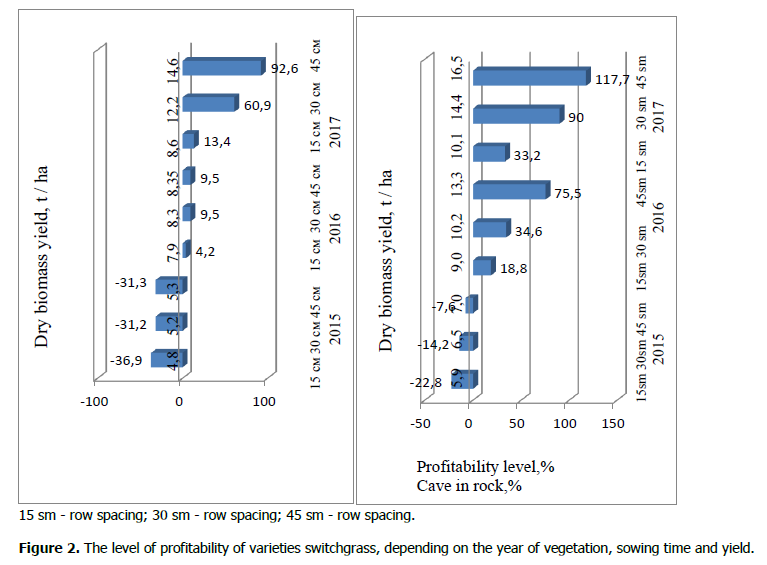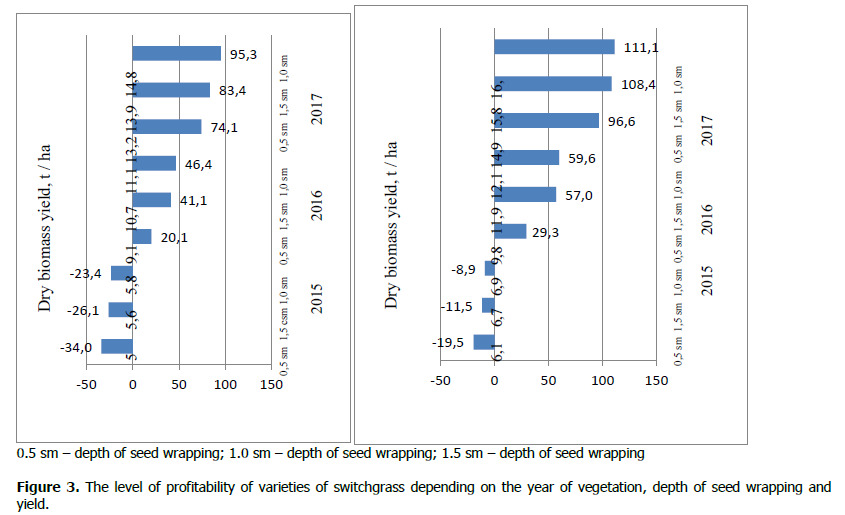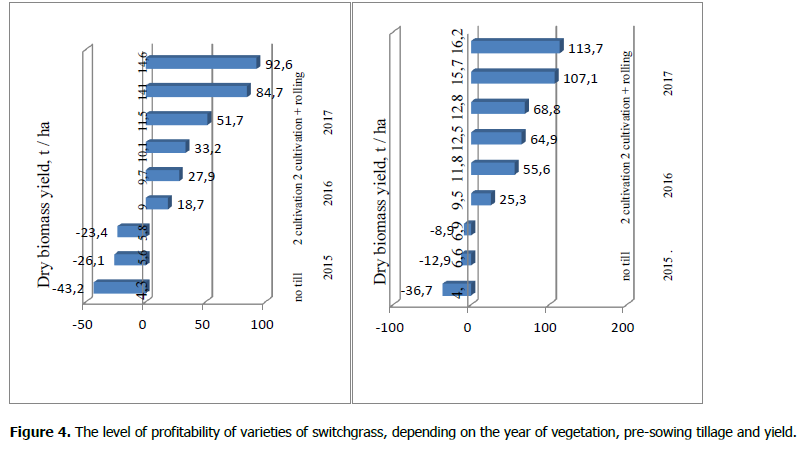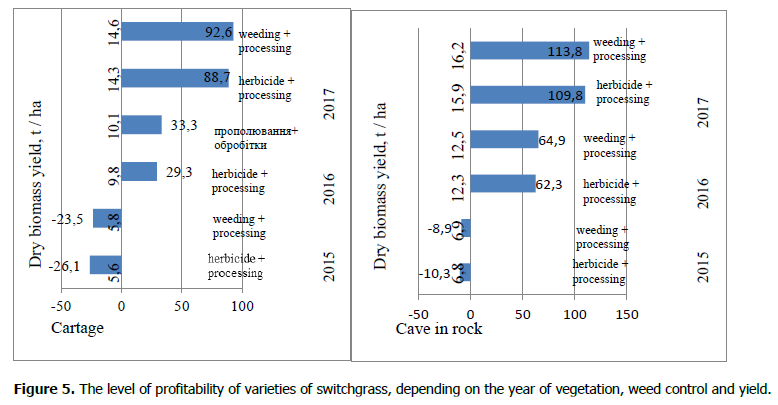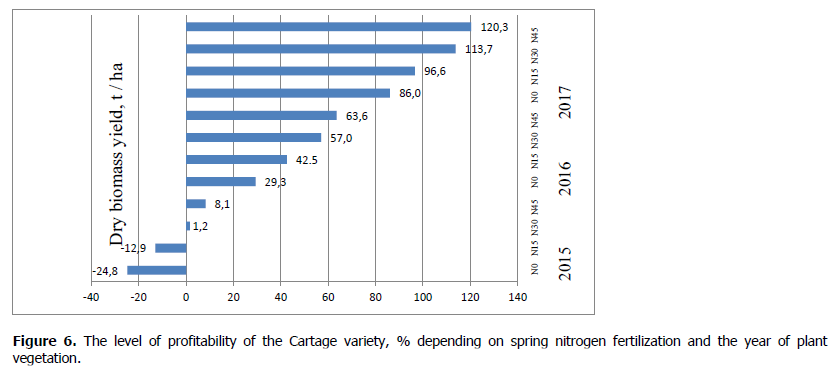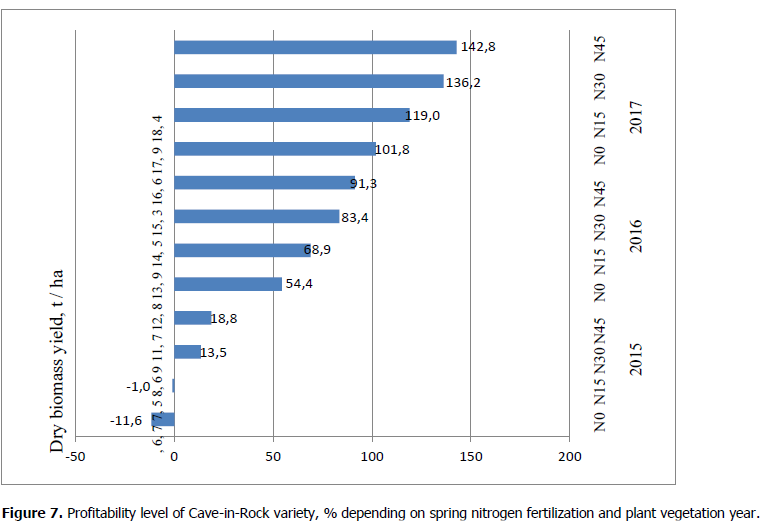Research Article - (2020) Volume 10, Issue 2
Abstract
The results of the conducted research show that the formation of bioenergy and economic efficiency of the phytomassswitchgrass –raw materials for biofuel production depends both on the assortment and weather conditions and on the elements of the technology of cultivation the culture. Quantitative indicators are determined, which determine the efficiency of crop production in the context of varieties put to study under different technological methods of cultivation. The influence of the investigated factors on the economic performance of the varieties of the sacramento is determined: Cave in rock and Cartage. It is proved that one of the important indicators that determines the efficiency of cultivation of switchgrass varieties and its value as a bioenergy crop is the output of energy from solid biofuels. It is determined that the optimal technological methods of cultivation make it possible to create the necessary conditions for the processes of plant growth and development, which ultimately will allow to obtain a higher energy output.
Keywords
Switchgrass; Performance elements; Economic and bioenergetic efficiency; Varieties
Introduction
Due to Ukraine's marked dependence on imported energy and the rise in price of gas and petroleum products, the urgent issue of monitoring and exploring the use of its own resources to obtain environmentally friendly and cheap renewable energy raw materials has emerged. As raw material for biofuels it is envisaged to use perennial plants that would be well acclimated to certain conditions and formed a high yield of phytomass for their cultivation on gray forest soils. Panicum virgatum L. – a plant that is well acclimated to the growing conditions in our country, generates high productivity with the appropriate quality of phytomass used as raw material for biofuel production.
Production efficiency is an economic category that reflects the essence of the extended reproduction process. That is, achieving the greatest results (effect) at the lowest cost (resources). Increasing production efficiency means that each unit of cost (resources) receives more output and revenue. In order to obtain an objective assessment of production efficiency, it is necessary to consider the cost (resources) that allow to obtain certain results. The energy potential of the vegetative above-ground mass of millet millet was determined according to the method of R.V. Morozov. One of the important indicators that determines the efficiency of cultivation of switchgrass varieties and its value as a bioenergy crop is the yield of energy from solid biofuels.
Materials and Methods
The researches were carried out in the conditions of the Yaltushkiv Experimental – Selection Station of the IBKICB of NAAS of Ukraine. The soil of the experimental sites – chernozem is podzolized. These soils are characterized by an average humus content of 3.2%. Acidity pH 5.8 close to neutral. The provision of rolling forms of the NRC is average. The research program was to determine the economic and energy efficiency of technological cultivation operations. Investigated varieties Cave in rock and Cartage.
Results and Discussion
Establishing optimum technological methods of cultivation gives the opportunity to create the necessary conditions for the growth and planting apertures, which ultimately will allow to obtain higher energy output (Table 1).
According to our research, the highest yield was obtained from the Cave-in-Rock and Cartage millet varieties of the experiment, where sowing was carried out in the first decade of May – 180 and 152.7 GJ/ha, and the energy efficiency ratio was 2.9 and 2.6.
Lower energy efficiency was obtained from the Cave-in-Rock and Cartage millet varieties of the experiment, where sowing was conducted in the third decade of April – 162.3 and 1391 GJ/ha, and the energy efficiency ratio was 2.7 and 2.4.
The late sowing in the third decade of May resulted in the lowest energy efficiency of the Cave-in-Rock and Cartage millet –158.2 and 135.0 GJ/ha and energy efficiency ratio of 2.6 and 2.3.
Thus, a higher energy yield of 180 and 152.7 GJ/ha was obtained for sowing seeds in the first decade of May. Earlier and later sowing periods provided lower energy output, which was 17.7 and 13.6 GJ/ha and 21.8 and 17.7 GJ/ha, respectively.
In addition to the sowing time, the study found that the row spacing also affected the energy output of switchgrass (Table 2).
The best option in terms of energy output is to grow plants with a row spacing of 45 cm, with this option a greater number of stems, pcs/m², was obtained, which provided a higher yield of switchgrass. The energy yield for growing plants with a row spacing of 45 cm was 184.1 and 140.5 GJ/ha, with an energy efficiency factor of 3 and 2.4. This option was more effective compared to growing plants with a row spacing of 15 cm by 60 and 34.1 GJ/ha, and, alternatively, with a row spacing of 30 cm by 28.6 and 11.0 GJ/ha.
| Sort (factor A) | Sowing time (factor B) | Entrance dry biomass, t/ha | Entrance solid biofuels from 1 ha, t/ha |
Energy output GJ/ha | Kee |
|---|---|---|---|---|---|
| Cave-in-rock | Sowing decade of the April third | 10, 8 | 11, 9 | 162, 3 | 2, 7 |
| Sowing decade of the May first | 12, 0 | 13, 2 | 180, 0 | 2, 9 | |
| Sowing decade of the May third | 10, 5 | 11, 6 | 158, 2 | 2, 6 | |
| Carthage | Sowing decade of the April third | 9, 3 | 10, 2 | 139, 1 | 2, 4 |
| Sowing decade of the May first | 10, 2 | 11, 2 | 152, 7 | 2, 6 | |
| Sowing decade of the May third | 9, 0 | 9, 9 | 135, 0 | 2, 3 |
Table 1. Energy characteristics of cultivation of switchgrass depending on the sowing time (2015-2017).
| Sort (factor A) | Sowing time (factor B) | Entrance dry biomass, t/ha | Entrance solid biofuels from 1 ha, t/ha |
Energy output GJ/ha | Kee |
|---|---|---|---|---|---|
| 15 sm | 8, 3 | 9, 1 | 124, 1 | 2, 2 | |
| Cave-in-rock | 30 sm | 10, 4 | 11, 4 | 155, 5 | 2, 6 |
| 45 sm | 12, 3 | 13, 5 | 184, 1 | 3, 0 | |
| 15 sm | 7, 1 | 7, 8 | 106, 4 | 1, 9 | |
| Carthage | 30 sm | 8, 6 | 9, 5 | 129, 5 | 2, 3 |
| 45 sm | 9, 4 | 10, 3 | 140, 5 | 2, 4 |
Table 2. Energy characteristics of the cultivation of vine millet depending on the row spacing (2015-2017).
Therefore, the higher energy yield was obtained in the variant of the study, where millets were grown with a row spacing of 45 cm, the energy yield was 184.1 and 140.5 GJ/ha, and the energy efficiency ratio was 3 and 2.4. The research resulted in a higher energy yield in an experiment where sowing was carried out at a depth of seed of 1 cm in the Cave-in-rock millet –175.9 and Cartage –159.5 GJ/ha, and the energy efficiency ratio was 2, 9 and 2.6 (Table 3). This variant provided a higher energy yield compared to the variant where the seed wrapping depth was 0.5 cm at 21.8 and 23.1 GJ/ha, and compared to the experiment where the sowing was carried out at a seed wrapping depth of 1.5 cm, turned out to be close to this option and exceeded it by only 2.7 and 8.1 GJ/ha. That is, sowing to a depth of 1.5 cm, in our opinion, due to sufficient moisture supply allows to obtain energy output, which is not significantly inferior to the option, where sowing was carried out to a depth of seed wrapping of 1 cm.
| Sort (factor A) | Sowing time (factor B) | Entrance dry biomass, t/ha | Entrance solid biofuels from 1 ha, t/ha | Energy output GJ/ha | Kee |
|---|---|---|---|---|---|
| 0, 5 | 10, 3 | 11, 3 | 154, 1 | 2, 6 | |
| Cave-in-rock | 1 | 11, 7 | 12, 9 | 175, 9 | 2, 9 |
| 1, 5 | 11, 5 | 12, 7 | 173, 2 | 2, 8 | |
| 0, 5 | 9, 1 | 10, 0 | 136, 4 | 2, 4 | |
| Carthage | 1 | 10, 6 | 11, 7 | 159, 5 | 2, 7 |
| 1, 5 | 10, 1 | 11, 1 | 151, 4 | 2, 6 |
Table 3. Energy characteristics of cultivation of switchgrass depending on the depth of seed wrapping (2015-2017).
Pre-sowing tillage should ensure the formation of friendly and even seedlings, the number of which should provide the necessary plant density, which will ultimately contribute to the formation of high yield varieties switchgrass.
Higher energy yields of 178.6 and 152.7 GJ/ha were obtained from an experiment where pre-sowing of the soil was carried out by performing two cultivations before and after germination in the Cave-in-Rock and Cartage varieties, and the energy efficiency coefficient was 2.9 and 2.6. Lower energy yield was obtained from an experiment where pre-sowing cultivation involved the implementation of two cultivations, which is 8.1 and 5.4 GJ/ha less.
Sowing seeds in untreated soil "no till" resulted in the lowest energy yield compared to other variants of the experiment, with energy output 43.6 and 28.6 GJ/ha less than the variant where pre-sowing included the implementation of two cultivations and pre- and post-harvest rolls of Cave in Rock and Cartridge (Table 4).
| Sort (factor A) | Sowing time (factor B) | Entrance dry biomass, t/ha | Entrance solid biofuels from ha, t/ha |
Energy output GJ/ha | Kee |
|---|---|---|---|---|---|
| 2-cultivation | 11, 4 | 12, 5 | 170, 5 | 2, 8 | |
| Cave-in-rock | 2-cultivation + rolling | 11, 9 | 13, 1 | 178, 6 | 2, 9 |
| «no till» | 9, 0 | 9, 9 | 135, 0 | 2, 3 | |
| 2-cultivation | 9, 8 | 10, 8 | 147, 3 | 2, 5 | |
| Carthage | 2-cultivation + rolling | 10, 2 | 11, 2 | 152, 7 | 2, 6 |
| «no till» | 8, 3 | 9, 1 | 124, 1 | 2, 2 |
Table 4. Yield of dry biomass of swissgrass, depending on pre-sowing tillage (2015-2017).
Weeds bring significant crop losses due to competition for light, nutrients and moisture. Therefore, obtaining high energy output is possible when fighting weeds effectively. The best variant of the experiment was determined depending on the weed control method, which provided higher energy yield for Coverage in Rock and Cartridge 178.6 and 152.7 GJ/ha, and the non-energy efficiency ratio was 2.9 and 2.6 (Table 5).
| Sort (factor A) | Weed control methods (factor B) | Entranc e dry biomass , t/ha |
Entrance solid biofuels from 1 ha, t/ha | Energy output GJ/ha | Kee |
|---|---|---|---|---|---|
| Control - manual weeding+ interrow processing with a period of 10-14 days | 11, 9 | 13, 1 | 178, 6 | 2, 9 | |
| Cave-in-rock | Primekstra TZ Gold 50% bhp - to sowing (4 l / ha)+row treatments with a period of 10-14 days |
||||
| 11, 7 | 12, 9 | 175, 9 | 2, 9 | ||
| Control - manual weeding+ interrow processing with a period of 10-14 days |
10, 2 | 11, 2 | 152, 7 | 2, 6 | |
| Carthage | Primekstra TZ Gold 50% bhp - to sowing (4 l / ha)+row treatments with a period of 10-14 days | ||||
| 9, 9 | 10, 9 | 148, 6 | 2, 5 |
Table 5. Drygrass biomass yield depending on weed control methods (2015-2017).
However, on the variant of thiolide, where jule is applied Primecstra TZ Gold soil herbicide 50% hp (4 l/ha) and row treatments yielded an energy yield that was slightly inferior to the previous variant and amounted to 175.9 and 148.6 GJ / ha, which is 2.7 and 4.1 GJ/ha less, and the energy efficiency factor was 2.9 and 2.5.
Thus, it can be argued that the variants of experiments that differed in the weed control method did not differ in energy yield and can be equated to the application of soil primer herbicide Primekstra TZ Gold 50% hp (4 l/ha) and inter-row energy output till control. Fertilizer application increased the energy yield of the variants of the experiment, where high nitrogen levels of 30-45 kg/ha (Table 6) were introduced into spring plant nutrition.
Thus, the highest energy yield was obtained from an experiment where in the spring fertilization of plants the rate of nitrogen of 45 kg/ha in the varieties of millet vine Cave in rock and Cartagе – 210 and 185.5 GJ/ha, which is higher compared to control at 42.3 and 23.2 GJ/ha. In addition, the high energy yield was obtained in the variant, where the rate of nitrogen of 30 kg/ha in the varieties of millet Cace-in-Rock and Cartage – 203.2 and 178.6 GJ/ha, which was 35, 5 and 16.3 GJ/ha beyond control.
When assessing the economic efficiency of agricultural production in agricultural enterprises, it is necessary to choose the system of interrelated indicators that most objectively reflect its level. Both natural and value indicators are widely used for this purpose.
When evaluating the economic efficiency of growing a millet, it was found that it is economically viable to grow from the third year of vegetation (Figure 1). According to the results of the studies, the profitability of millet varieties of grapevine in the third year of vegetation, depending on the sowing time, amounted to 9.6-35.9% in the Cartage variety, and in the Cave-in-rock variety – 33.2-67.6%. Higher economic efficiency was established for millet varieties of the fourth year of vegetation and amounted to 78.1-91.3% in Cartage and 100.6-119% higher in Cave-in-Rock.
| Sort (factor A) | Nitrogen feeding (factor B) | Entrance dry biomass, t/ha | Entrance solid biofuels from 1 ha, t/ha | Energy output GJ/ha | Kee |
|---|---|---|---|---|---|
| N 0 â?? control | 11, 2 | 12, 3 | 167, 7 | 2, 8 | |
| Cave-in-rock | N 15 | 12, 3 | 13, 5 | 184, 1 | 3, 0 |
| N 30 | 13, 5 | 14, 9 | 203, 2 | 3, 3 | |
| N 45 | 14, 0 | 15, 4 | 210, 0 | 3, 4 | |
| N 0 â?? control | 9, 9 | 10, 9 | 148, 6 | 2, 5 | |
| Carthage | N 15 | 10, 8 | 11, 9 | 162, 3 | 2, 7 |
| N 30 | 11, 9 | 13, 1 | 178, 6 | 2, 9 | |
| N 45 | 12, 4 | 13, 6 | 185, 5 | 3, 0 |
Table 6. Energy characteristics of the cultivation of millet vines dependent on nitrogen feeding (2015-2017).
Figure 1. The level of profitability of varieties switchgrass, depending on the year of vegetation, sowing time and yield.
Growing the same varieties of millet in the second year of vegetation is not economically advantageous for the Cartage variety, the level of profitability ranged from 24.8 to 34.1%, and Cate-in-rock varieties from 10.3 to 20.8%, depending on sowing time, this value varied from the level of dry biomass yield.
The level of profitability of millet varieties depended first of all on the year of vegetation (Figure 2), the row spacing, variety features.
The highest level of profitability was obtained in millet varieties of the fourth year of growing season with row spacing of 45 cm– 92.6% in the Cartage variety and 117.7% in the Cave in Rock variety. The lower level of profitability was obtained from a variant of the experiment in 2016, where the row spacing was 30 cm in the Cave in Rock millet varieties –90% and Cartage –60.9%.
In the third year of millet vegetation, the profitability of Cartag – 9.5 and Cave in rock – 75.5% for row spacings of 45 cm was also obtained. from 31.2% to 36.9%, and in Cave in rock from 7.6% to 22.8%.
The level of profitability of varieties of millet vines from the year of vegetation, depth of seed wrapping and yield (Figure 3).
According to the results of research, it was found that the highest profitability of cultivating millet vine in plants of the fourth year of vegetation in the Cave-in-rock varieties –111.1% and in Carthage – 95.3% and at a depth of seed wrapping of 1.0 cm. the value of profitability was obtained for the cultivation of millet vine in the fourth year of vegetation at depths of seed wrapping in Cave-in-rock varieties –108.4% and Cartage –83.4%.
In the plants of vine millet in the third year of vegetation, the highest level of profitability was obtained in the variant of the experiment, where the depth of seed wrapping was 1.0 cm in Cave-in-rock varieties – 59.6% and Cartage –46.4%.
Growing plants in the second year of the prosalose of the prominent is not economically efficient; the profitability of the Cave in Rock and Cartage millet varies from –8.9 to –19.5% and –23.4 to –34, 0, respectively.
Figure 2. The level of profitability of varieties switchgrass, depending on the year of vegetation, sowing time and yield.
Figure 3. The level of profitability of varieties of switchgrass depending on the year of vegetation, depth of seed wrapping and yield.
In Figure 4, shows the level of profitability of vine varieties depending on the surface tillage, the year of vegetation and yield.
Figure 4. The level of profitability of varieties of switchgrass, depending on the year of vegetation, pre-sowing tillage and yield.
The highest level of profitability was obtained in the variant of the experiment, where two pre-sowing cultivations and pre- and post-germination rolls of Cave-in-Rock varieties 113.7% and Cartage 92.6% in the fourth year of vegetation were carried out. In addition, a high level of profitability was obtained in the variant of the experiment, where only two pre-sowing cultivations were carried out in millet varieties of the fourth year of vegetation: Cave in rock – 107.1 and Cartage – 84.7%. In this variant of the experiment, the highest level of profitability was obtained in plants of the third year of vegetation of the Cave in Rock varieties – 64.9 and Cartage – 33.2%, but the level of profitability was lower compared to the cultivation of plants of the fourth year of vegetation. Growing plants in the second year of vegetation was not effective, the level of profitability in varieties of Cartage from 8.9 to 36.7% and Cave-in-rock from 23.4 to 43.2%. In Figure 5 presents the economic efficiency of vine millet cultivation depending on the year of vegetation, pre-sowing tillage and varietal characteristics.
Figure 5. The level of profitability of varieties of switchgrass, depending on the year of vegetation, weed control and yield.
According to the results of the research, the highest level of profitability was obtained in the variant of the experiment, where manual weeding and interrow treatments were carried out in the plants of millet vines in the fourth year of vegetation. The profitability of Cave-in-Rock varieties is 113.8% and Cartridge is 92.6%. However, slightly inferior to this variant, the variant of the experiment, where the soil herbicide was introduced and row treatments were carried out, the level of profitability was at the Cave in rock varieties –109.8 and Cartage – 88.7%. In plants of the third year of cultivation, the highest level of profitability was obtained in the variant of the experiment, where manual weeding and interrow cultivation were carried out, in Cave in rock varieties – 64.9 and Cartage – 33.3%. The highest level of profitability of Cave in rock varieties – 62.3 and Cartage – 29.3% was obtained for application of soil herbicide and conduct of tillage. Growing millet vine in the second year of vegetation was not effective, as the level of profitability on the options studied ranged from – 8.9 to – 26.1% in the varieties of millet vine Cave in rock and Cartage. The level of profitability of the Cartage variety depending on the nitrogen fertilization and the year of plant vegetation (Figure 6).
Figure 6. The level of profitability of the Cartage variety, % depending on spring nitrogen fertilization and the year of plant vegetation.
Higher cost-effectiveness was obtained from a variant of the experiment, where the spring fertilization of plants of the millet of the fourth year of vegetation with a norm of nitrogen of 45 kg/ha was carried out and the level of profitability of 120.3% was obtained in the Cartage variety of plants of the fourth year of vegetation. In addition, this year's vegetation showed a high level of profitability – 113.7% for the introduction in the spring fertilization of plants with a norm of nitrogen of 30 kg/ha.
In plants of the second year of vegetation, the highest level of profitability - 63.6% and 57.0% was obtained on the variant of the experiment, where it was introduced in spring fertilization of plants with the norm of nitrogen of 45 and 30 kg/ha in the Cartage variety.
Economical efficiency in plants of the second year was observed in only one variant, where it was introduced in the spring fertilization of plants in the rate of nitrogen 45 kg/ha, and the level of profitability was 8.1%.
Cave-in-rock millet plants had the highest level of profitability in the experiment, where the spring fertilization of millet plants in the fourth year of vegetation with a norm of nitrogen was 45 kg/ha, and the profitability level was 142.8% (Figure 7).
Figure 7. Profitability level of Cave-in-Rock variety, % depending on spring nitrogen fertilization and plant vegetation year.
In addition, the high cost-effectiveness was obtained in the variant of the experiment, where it was introduced into the plants of the fourth year of vegetation in the feeding rate of nitrogen of 30 kg/ha, and the level of profitability was 136.2%. Also, for the cultivation of plants, millets of the third year of vegetation obtained the highest economic efficiency on the variants of the experiment, where the spring fertilization of plants with nitrogen norms of 30 and 45 kg / ha was carried out, and the level of profitability was 83.4 and 91.3%.
Conclusion
Based on the results of field and laboratory studies, production testing, as well as on the basis of energy assessment by the agroforestry of Right-Bank Ukraine to obtain high yields of dry biomass of the switchgrass: under favorable weather and climatic conditions, sowing should be carried out in the first decade of May with the depth of seed wrapping 1-1.5 cm varieties of millet vine Cave in rock and Cartage; the advantage of providing a method of sowing with a row spacing of 45 cm and a seeding rate of 300 pieces/m² of plants; to create favorable conditions for seed germination, to obtain uniform and friendly seedlings to carry out two pre-sowing cultivations, before and after germination of soil; to carry out the application of Primekstra TZ Gold soil herbicide 50% hp to effectively control weeds (4 l/ha) before sowing and row treatments with a period of 10-14 days. It is advisable to use nitrogen fertilization of plants with a nitrogen rate of 30-45 kg/ha for obtaining high yields of millet vine.
References
Bandura, V., Mazur, V., Yaroshenko, L., Rubanenko, O. (2019). Research on sunflower seeds drying process in a monolayer tray vibration dryer based on infrared radiation. INMATEN – Agricultural Engineering, 57: 233-242.
Bransby, D. I. Compatibility of switchgrass as an energy crop in farming systems of the southeastern USA. D. I. Bransby, R. Rodriguez- Kabana,
Ermakov, А., Arasymovych, V., Yarosh, N. (1987). Methods Studies biochemically plants. L.: Agropromizdat, P. 430. Esbroeck, G. A., Hussey, M. A., Sanderson. M. A.(1997). Crop Sci, 37: 864–870.
Ishchenko, V., Belyakov, A. (2009). Efficiency of micronutrients, growth regulator and ryzohuminu in increasing productivity varieties of peas without leaves type. Steppe Bulletin. 6:37-41.
Kolesnik, S. (2012). Bacterial fertilizer to optimize nitrogen and phosphorus nutrition soybeans, chickpeas, peas, lentils and commit. Feed and fodder. 73:145-151.
Ma, Z. (2001). Impact of row spacing, nitrogen rate, and time on carbon partitioning of switchgrass Z. Ma, C. W. Wood, D. I. Bransby. Biomass Bioenergy, 20: 413–419.
Malchevskaya, E., Mylenkaya, G. (1981). The comments and Animal Husbandry quality forage analysis. Minsk, Harvest, 143.
Mazur, V. A., Myalkovsky, R.O., Mazur, K. V., Pantsyreva, H. V., Alekseev, O.O. (2019). Influence of the Photosynthetic Productivity and Seed Productivity of White Lupine Plants. Ukrainian Journal of Ecology, 9(4), 665-670.
Mazur, V.A., Didur, I.M., Pantsyreva, H.V., Telekalo, N.V. (2018). Energy-economic efficiency of grain-crop cultures in the conditions of the right-bank Forest-Steppe of Ukraine. Ukrainian J Ecol, 8(4), 26-33.
Mazur, V.A., Pantsyreva, H.V., Mazur, K.V., Didur, I.M., (2019). Influence of the assimilation apparatus and productivity of white lupine plants. Agronomy research. 17(1), 206-219.
Melnychuk, T., Patyka, V. (2011). Microbial preparations bioorganic farming system. Collected articles "Third All-Ukrainian Congress of Ecologists with international participation." Vinnytsya. Tom.2: 423-426.
Muir J. P. (2001). Biomass production of Alamo switchgrass in response to nitrogen, phosphorus, and row spacing. J. P. Muir, M. A. Sanderson, W. R. Ocumpaugh at all. AgronJ., 93. Р. 896–901.
Ovcharuk V.I., Mulyarchuk O.I., Myalkovsky R.O., Bezvikonnyi P.V., Kravchenko V.S., Klymoych N.M. (2019). Parameters of beet plants. Bulletin of the Uman National University of Horticulture.1: 70–75.
Pantsyreva H.V. (2018). Research on varietal resources of herbaceous species of Paeonia L. in Ukraine. Scientific Bulletin of the NLTU of Ukraine, 28 (8), 74-78. https://doi.org/10.15421/40280815
Pantsyreva, H.V. (2019). Morphological and ecological-biological evaluation of the decorative species of the genus Lupinus L.. Ukrainian Journal of Ecology, 9(3), 74-77.
Pantsyreva, H.V. (2019). Morphological and ecological-biological evaluation of the decorative species of the genus Lupinus L.. Ukrainian Journal of Ecology, 9(3), 74-77.
Pantsyreva, H.V. (2019). Technological aspects of biogas production from organic raw materials. Bulletin of KhNTUSG them. P. Vasilenko. Kharkiv, 276-290.
Sladden, S.E. (1993). Biomass Conf. of the Americas. Burlington, 229–234.
Skoromna, O.I., Razanova, O.P., Tkachenko, T.Y. (2019). Effect of lysine feeding allowance on growth performance and carcass characteristics of growing pigs. Ukrainian Journal of Ecology, 9(4), 646-650.
Telekalo N., Mordvaniuk M., Shafar H., Matserа O. (2019). Agroecological methods of improving the productivity of niche leguminous crops/ Ukrainian Journal of Ecology. 9(1). 169-175.
Telekalo, N. (2014). Effect of inoculation and foliar fertilizings on yield varieties peas. Legumes and cereals cultures. (9): 16-22.
Kuryata, V.G., Polyvanyi, S.V., Shevchuk, О.А., Tkachuk. О. (2019). Morphogenesis and the effectiveness of the production process of oil poppy under the complex action of retardant chlormequat chloride and growth stimulant treptolem. Ukrainian Journal of Ecology. 9 (1). 127-134.
Vdovenko, S.A., Pantsyreva, G.V., Palamarсhuk, I.I., Lytvyniuk, H.V. (2018). Symbiotic potential of snap beans (Phaseolus vulgaris L.) depending on biological products in agrocoenosis of the right-bank forest-steppe of Ukraine. Ukrainian J Ecol, 8(3), 270-274.
Vdovenko, S.A., Prokopchuk, V.M., Palamarchuk, I.I., Pantsyreva, H.V. (2018). Effectiveness of the application of soil milling in the growing of the squash (Cucurbita pepo var. giraumontia) in the right-benk forest stepp of Ukraine. Ukrainian J Ecol, 8(4), 1-5.
Vitalii, Palamarchuk., Inna, Honcharuk., Tetiana, Honcharuk., Natalia, Telekalo. (2018). Effect of the elements of corn cultivation technology on bioethanol production under conditions of the right- bank forest-steppe of Ukraine. Ukrainian Journal of Ecology. 8(3). 47-53.
Shevchuk,О.А.,Tkachuk,О.,Kuryata,G.,Khodanitska,О.О.,Polyvanyi,S.V. 2019. Features of leaf photosynthetic apparatus of sugar beet under retardants treatment. Ukrainian Journal of Ecology. 2019. 9 (1). Р. 115-120.
Khodanitska,О.О.,Kuryata,V. G.Shevchuk,O.A.,Tkachuk,O.O.,Poprotska. I.V. (2019). Effect of treptolem on morphogenesis and productivity of lin seed plants. Ukrainian Journal of Ecology.9 (2). 9-126.
Author Info
V.A. Mazur, Y.Y. Branitskyi and H.V. Pantsyreva*Citation: Mazur, V.A., Branitskyi, Y.Y., Pantsyreva, H.V.(2020). Bioenergy and economic efficiency technological methods growing of switchgrass. Ukrainian Journal of Ecology , 10 (2), 8-15.
Received: 03-Mar-2020 Published: 29-May-2020, DOI: 10.15421/2020_56
Copyright: This is an open access article distributed under the terms of the Creative Commons Attribution License, which permits unrestricted use, distribution, and reproduction in any medium, provided the original work is properly cited.


